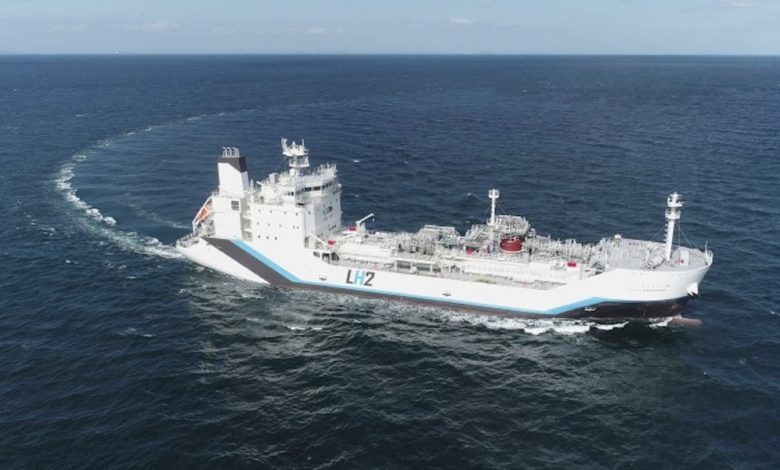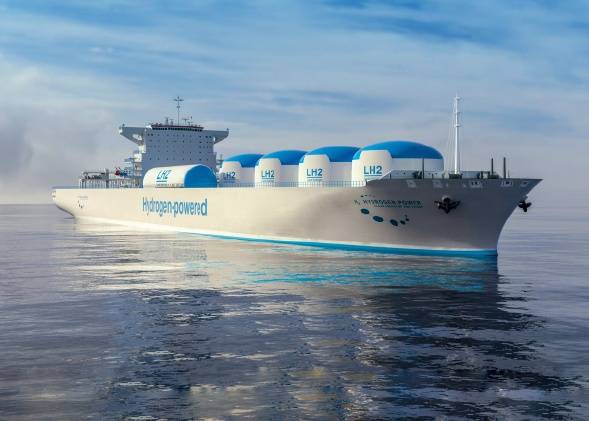There are 443 vessels currently transporting ammonia worldwide
Thirty million hydrogen tonnes would represent only 5% of the global demand expected in 2050
The International Chamber of Shipping (ICS) launches new report identifying that heavy Industry sector are expected to dominate global hydrogen demand to 2050, with South Korea, Japan and Europe being the first markets for hydrogen.
Report highlights that to meet just 30 million tonnes of annual global green hydrogen demand, the world would require up to 411 new hydrogen vessels and the equivalent of the yearly electricity production of South and Central America combined
The International Chamber of Shipping (ICS) – presents a new report, written by the Professor of Energy Economics at Biberach University of Applied Sciences, Germany, identifying hydrogen demand sectors, demand locations and the demand-pull timeline at the Malaysia Maritime Week event.
The ground-breaking report titled “Turning hydrogen demand into reality: Which sectors come first?” focuses on the potential of clean hydrogen to function as an energy carrier and feedstock to decarbonise multiple sectors, especially hard to abate sectors. The report identifies that to meet future hydrogen demand, the scale of renewable electricity demand for green hydrogen production is unprecedented and leads to once-in-a-generation opportunities and challenges.
It is noteworty that the International Chamber of Shipping ( ICS ) in collaboration with Professor Dr Stefan Ulreich, examine the role of hydrogen in global decarbonisation efforts, and particularly the role of maritime shipping as an enabler of a hydrogen economy.
Barriers and opportunities
The report identifies the key sectors that drive hydrogen demand, sets out barriers and opportunities for growth, explores geographical demand hotspots, and outlines a timeline for sectoral adoption. It concludes that more infrastructure is required to support the emerging hydrogen economy.
Turning hydrogen demand
The report titled “Turning hydrogen demand into reality: Which sectors come first?” focuses on the potential of clean hydrogen to function as an energy carrier and feedstock to decarbonise multiple sectors, especially hard to abate sectors.
The report identifies that to meet future hydrogen demand, the scale of renewable electricity demand for green hydrogen production is unprecedented and leads to once-in-a-generation opportunities and challenges.

Executive summary
Clean hydrogen has the potential to function as an energy carrier and feedstock to decarbonise multiple sectors (especially hard-to-abate sectors) and support global decarbonisation efforts by 2050 and beyond.
Energy security
The main driver for hydrogen demand in multiple sectors is the target of abatement of emissions. Making hydrogen from clean sources, its infrastructure and transportation available at scale in various regions would be key to secure a diversified supply and contribute to a global low-carbon energy security.

Clean sources
Currently, ¾ of hydrogen use is concentrated in refining operations and chemical processes (such as the production of ammonia, fertilizers and desulphuration of fuels), it is mainly produced on-site and based almost entirely on fossil fuels.
Current methods of global hydrogen production led to more than 900Mt of CO2 emissions in 2022 [note 1], i.e. slightly higher than current maritime emissions of 706Mt in 2022 [note 2]. For hydrogen increase to support decarbonisation, it would need to be developed from clean sources.
Fossil fuels
According to the International Energy Agency (IEA) hydrogen use is expected to remain almost stagnant and within current industrial use cases into 2030.
Not all sectors will require the same degree of transformation and infrastructure to be built to incorporate hydrogen as a replacement for fossil fuels.
Existing hydrogen demand
To go beyond the existing hydrogen demand by existing sectors – predominantly refining and chemical processes – infrastructure and power access barriers need to be addressed for new sectors to begin uptake of hydrogen.
Hydrogen demand could double by 2040, with most of the additional demand coming from industrial sectors – as it is easier to uptake – acting as a baseload, the rest coming from new industrial uses and a small share of the total (less than 5%) from transport sectors.
Regulatory conditions
For global hydrogen demand to keep the net-zero by 2050 scenario within reach, demand would need to scale five times from current levels to reach nearly 500 million tonnes from 2030 to 2050.
Additional multiple sectors and their regulatory conditions, infrastructure and ecosystems would need to be prepared to uptake hydrogen to scale up hydrogen use.
Road, shipping and aviation sectors are expected to increase their share of total hydrogen demand from 2034 onwards, potentially reaching 17% of total hydrogen demand from all transport sectors by 2050.
Expectation IRENA
As the IEA sets out, the overall contribution of hydrogen in the energy sector could increase from 1.8% in 2022 to 5.7% in 2050 under the IEA Announced Pledges Scenario and reach 14% of global final energy demand by 2050 according to the International Renewable Energy Agency (IRENA).
IRENA expects 90% of future hydrogen production to come from renewable sources, making electrification the pathway for production of hydrogen
Europe has a target of 20 million tonnes per year by 2030 with half of that volume to come from imported sources.
These two Asian economies have a projected combined hydrogen demand of 30 million tonnes per year by 2050 (a 10x increase for Japan and 177x for South Korea respectively from current levels), with more than half of hydrogen to come by imports.
Europe has a target of 20 million tonnes per year by 2030 with half of that volume to come from imported sources.

America electricity production
There are 443 vessels currently transporting ammonia worldwide, but to meet the expected demand of 20 million tonnes of hydrogen of the EU , the fleet will need to increase by up to 300 vessels for the EU 2030 target,
Thirty million hydrogen tonnes would represent only 5% of the global demand expected in 2050 and to meet that demand the world would require the equivalent production of the total South and Central America electricity production (if all production comes from renewable sources).

Renewable electricity
Renewable electricity is considered a cornerstone for achieving a climate-neutral energy system and hence an essential solution for transport and heating/cooling.
However, this also leads to competition for green electricity that is also needed to produce green hydrogen.
Hydrogen economy
Since the power demand for hydrogen electrolysis is enormous (reaching up to 25,000 TWh in the most optimistic scenario), the global power system would need to grow more than the tripling of renewable energy commitment announced at COP28 to make a hydrogen economy a reality.
Without this, the transition to a hydrogen economy will be stifled and will not deliver on the objectives of the EU and the leading Asian governments.
Fuelling uncertainty for businesses and adding barriers to potential investments. Expected hydrogen demand ranges from 90Mt to 600Mt by 2050, equivalent to 4% and 11% of total global energy supply by 2050.





